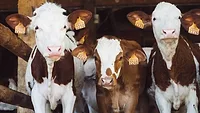Enhancing the Safety of Dairy and Other Animal Based Foods
The Food and Drug Administration’s (FDA) responsibility for ensuring the safety and security of roughly 80% of the U.S. food supply falls primarily upon its Center for Food Safety and Applied Nutrition (CFSAN). To more efficiently accomplish its goals, CFSAN is subdivided into many offices and divisions. The Division of Dairy and Egg Safety in the Office of Plant and Dairy Foods is charged with developing and implementing policies that ensure the safety of all foods derived from animal products, except meat, poultry and certain egg products under the U.S. Department of Agriculture’s (USDA) purview.
This article discusses some of the many priority issues the Division of Dairy and Egg Safety is currently working on to better protect American consumers. Because FDA provided an update on egg safety in the April/May 2004 issue of Food Safety Magazine, this article will focus on current efforts related to dairy and other animal based products. Topics covered include dairy compliance policy guides and the Federal Import Milk Act, 60-day aging of cheese, application of the Listeria Action Plan to cheeses, transmissible spongiform encephalopathy (TSE) agents, and game meats.
Dairy Safety
Compliance Policy Guides and the Federal Import Milk Act. Compliance policy guides (CPGs) are one of the tools FDA uses in regulating the food supply. CPGs are developed by FDA to explain how the agency will enforce a regulation or a given statute. They are a guide for FDA inspectors, and transparently convey to industry members, the general public and any other interested parties, FDA’s expectations when evaluating a firm’s compliance with regulations and policies. Since regulations, policies and industry practices are subject to change, CPGs eventually may require review and updating. Efforts are now underway to update existing CPGs, as needed, and to rescind others that are obsolete. Of those CPGs that need updating, several are related to the dairy sector, and the first dairy CPG slated for updating is for the Federal Import Milk Act (FIMA).[1]
FIMA is a relatively obscure statute dating from 1927; however, it is still administered by FDA under regulations in 21 CFR 1210 et seq. The basic tenets of FIMA are that anyone exporting milk or cream to the U.S. must apply for and receive a permit prior to shipping such products to the U.S. The regulations describe in detail the requirements that must be met before an application for a permit will be approved.
FDA is faced with the challenge of determining which new dairy products are subject to regulation under FIMA. Unfortunately, the existing CPG overstates the scope of products covered by FIMA. As a result, CFSAN receives frequent questions from both industry and field investigators asking for clarification. The new revised CPG, which is in the final stages of clearance, will clarify which products are covered under FIMA, and should eliminate the confusion that has existed until now.
60-Day Aging of Cheese. FDA receives inquiries from industry on the standards of identity for cheeses that permit use of raw milk (21 CFR 133 et seq.). FDA generally requires that the resulting cheese be aged for a minimum of 60 days at a temperature of not less than 35°F. This requirement was put in place years ago because it was believed that such an aging process acted to reduce the level of pathogens present in the cheese, thus making it safer for consumption. However, several years ago, researchers at South Dakota State University published a study showing that 60-day aging was largely ineffectual in reducing levels of E. coli O157:H7 in cheddar cheese.[2] Consequently, FDA sought advice from the National Advisory Committee for Microbiological Criteria for Food (NACMCF) as to whether the efficacy of 60-day aging should be reexamined. NACMCF advised that it should be, and FDA began additional research into the efficacy of 60-day aging at pathogen reduction. Since then, research by Dr. Joseph Schlesser of the National Center for Food Science and Technology (NCFST) in Summit-Argo, IL, also has supported the finding that 60-day aging is largely ineffectual as a means of reducing levels of certain pathogens in cheeses. With this information in hand, FDA is now developing a risk profile for raw milk cheeses, which will aid in the Agency’s assessment of the requirements for processing these cheeses.
Applying the Listeria Action Plan to Cheeses. In September 2003, FDA released a risk assessment for Listeria monocytogenes (“Quantitative Assessment of Relative Risk to Public Health from Foodborne Listeria monocytogenes Among Selected Categories of Ready-To-Eat Foods”[3]). Subsequently, FDA developed an action plan for combating Listeria monocytogenes in ready-to-eat foods, and several of the action items contained within that plan have resulted in new efforts to improve the safety of cheeses.[4]
One of FDA’s goals is to develop an action plan to address the unlawful importation of cheeses. FDA has become aware that some cheeses are being imported for personal use, but are later being sold commercially through various venues. The dangers posed by these products cannot be overstated. With no guarantee that proper processing, packaging, handling and storage of these cheeses has taken place, individuals who consume these products are at greater risk for contracting listeriosis, intoxication from E. coli, salmonellosis and campylobacteriosis. In fact, there have been outbreaks of foodborne illness associated with unlawfully imported cheeses in the past, and FDA strongly advises that only properly labeled products, manufactured in a suitable and safe environment, be purchased and consumed. Developing an effective strategy to combat this problem will involve the concerted efforts of FDA, several other federal and state agencies, and perhaps the governments of the countries from which these products originate.
The health risk posed by “gourmet” or “premium” cheeses is another area of concern. These cheeses typically are imported from European countries and are highly prized for their unique flavors and textures. Often they are made from raw milk and aged for less than 60 days, intravening current federal regulations that do not permit interstate commerce in raw milk cheeses. 21 CFR 1240.61 requires that all milk and milk products that are packaged for retail sale and that are in interstate commerce must be made from pasteurized milk. The exceptions to that regulation are the cheese standards in 21 CFR 133 et seq., which were mentioned earlier in this article. FDA is currently developing a field assignment that will provide a better picture of how many gourmet cheeses on the market may be in violation of FDA’s regulations. With that information, FDA can better develop a strategy to eliminate potentially harmful cheeses from the market.
The manufacture and sale of so-called “bathtub” cheeses is yet another issue that poses public health concerns, but seldom involves interstate commerce. Typically, these cheeses are made in the home under conditions that are less than ideal for the safe and sanitary manufacture of cheese. While individual states have addressed this issue to varying degrees, we continue to see outbreaks of listeriosis traceable to the consumption of these cheeses. Unfortunately, in recent years, such outbreaks also have resulted in several fatalities. FDA has developed outreach programs to educate consumers about the risks of consuming “bathtub” cheeses and to inform them of safe alternatives available in retail markets. Today’s retailers are typically stocked with a variety of cheeses from all over the world, including domestic versions of cheese varieties that previously had to be imported. With such a selection available, there is no reason to risk the serious illness that may result from consuming a “bathtub” cheese.
Animal-based Product Safety
Because the Division of Dairy and Egg Safety also oversees the safety of FDA-regulated food products that contain very small amounts of meat, as well as game meats, the Division has been instrumental in developing regulations related to Chronic Wasting Disease (CWD) and bovine spongiform encephalopathy (BSE). CWD and BSE are transmissible spongiform encephalo-pathies (TSEs), a group of fatal, neurodegenerative diseases. CWD affects deer and elk, while BSE affects cattle. Other diseases in this category are scrapie, which can afflict sheep and goats, and Creutzfeldt-Jakob disease in humans.
Chronic Wasting Disease. In April 2001, FDA published its intention to pursue rulemaking related to CWD.[5] The disease has been identified in wild and farmed elk and in deer populations. To date, it has been found in cervid populations in certain areas of Wisconsin, Colorado, Nebraska, Wyoming, Kansas, Montana, Oklahoma, South Dakota, New Mexico, Minnesota and Canada.
In 1999, the World Health Organiza-tion indicated that there was no evidence that CWD could be transmitted to humans. Nonetheless, it also suggested that any part of a deer or elk believed to be diseased should not be eaten. Since the results of some studies using in vitro techniques have suggested that transmission to humans could occur. Yet, currently there are no validated analytical tests to identify animals in the preclinical phase of CWD, or any other TSE. Additionally, CWD typically exhibits a long incubation period, during which time animals appear normal but are potentially infectious. In light of these facts, FDA is planning to issue a proposed rule that, if finalized, would prohibit the use of cervids in food (including dietary supplements) and cosmetics if the cervids have been exposed to CWD. In doing so, FDA hopes to further protect the public from potential harm.
Bovine Spongiform Encephalopathy. In December 2003, USDA diagnosed a cow with BSE in the U.S. Both USDA and FDA responded to this finding by ensuring that the existing firewalls against the disease were working and by announcing new measures to further strengthen efforts to prevent BSE in the U.S. Because material from cattle may potentially be found in a wide range of CFSAN-regulated products, from soups, stews and flavors to various cosmetics, on Jan. 26, 2004, FDA announced its intention to ban from human food (including dietary supplements) and cosmetics, a wide range of bovine-derived material. In doing so the same safeguards that protect Americans from exposure to the agent of BSE through meat products regulated by USDA would also apply to food products and cosmetics that FDA regulates.
On July 14, 2004, FDA published a BSE Interim Final Rule (IFR) banning the use of prohibited cattle materials (which may contain BSE agents) in food, including dietary supplements, and in cosmetics. Prohibited cattle materials include: specified risk materials (brain and other nervous system tissue from cattle 30 months and older; and the tonsils and distal ileum of all cattle); the small intestine from all cattle of any ages; material from nonambulatory disabled cattle; material from cattle not inspected and passed for human consumption; and mechanically separated beef. The rule was immediately effective, but FDA concurrently opened a 90 day comment period. On the same day, FDA also published a BSE recordkeeping proposed rule, a companion to the IFR, requiring manufacturers and processors of human food, dietary supplements, and cosmetics that are manufactured from, processed with, or otherwise contain material from cattle to establish and maintain records. Both can be viewed on FDA’s website.
Game Meats. FDA regulates all meats, including most if not all types of game meats, that are not under the jurisdiction of USDA. Some examples of game meats that FDA regulates are: elk, deer, antelope, bison, rabbit, squirrel, opossum, raccoon, nutria, wild turkey, geese, and nonaquatic reptiles such as land snakes. The Division of Dairy and Egg Safety currently is identifying facilities that process game meats for interstate commerce or that manufacture products containing game meat. It also is developing a field assignment that will include some inspections during the next fiscal year. This field assignment will enhance FDA’s knowledge of this industry and ensure that products are produced under satisfactory conditions and comply with all applicable food safety requirements.
A Wide Scope
This is only a brief snapshot of a few of the food safety issues with which the Division of Dairy and Egg Safety deals on a daily basis. The Division’s area of responsibility is broad-ranging, from fluid milk and processed dairy products, such as yogurt, ice cream, and cheese, to game meats, TSEs and eggs. To address this wide scope of responsibility the Division’s veterinarians, food technologists, dairy and egg scientists and protein chemists—many with experience in the regulated industries—work to assure the safety of animal-based food products regulated by FDA.
John Sheehan is the Director of the Division of Dairy and Egg Safety. He is a food technologist and an attorney and has worked for FDA for four years.
Robert Childers is a Captain in the Commissioned Corps of the United States Public Health Service and Chief of the Implementation and Compliance Branch within the Division of Dairy and Egg Safety.
Sebastian Cianci is a policy analyst for CFSAN and a member of the Center’s Executive Operations Staff.
Acknowledgment
The authors thank Louise Dickerson and Rebecca Buckner, Ph.D., of CFSAN for their assistance in reviewing and editing this article.
References
1. U.S. FDA. Federal Import Milk Act. www.fda.gov/opacom/laws/fimilkat.htm.
2. Reitsma and Henning. Journal of Food Protection, (59)5:460-464. 1996.
3. U.S. FDA. Quantitative Assessment of Relative Risk to Public Health from Foodborne Listeria monocytogenes Among Selected Categories of Ready-To-Eat Foods. www.foodsafety.gov/~dms/lmr2-toc.html.
4. FDA/CDC 2003 Update of Listeria Action Plan. cfsan.fda.gov/~dms/lmr2plan.ht ml.
5. U.S. FDA. TSE Action Plan, Item 22. www.fda.gov/oc/oca/roundtable/bse/FDA_actionplan.html.
Looking for quick answers on food safety topics?
Try Ask FSM, our new smart AI search tool.
Ask FSM →








